.

Dawn Probe Spots a Bright Surprise on Ceres: Is It Ice?
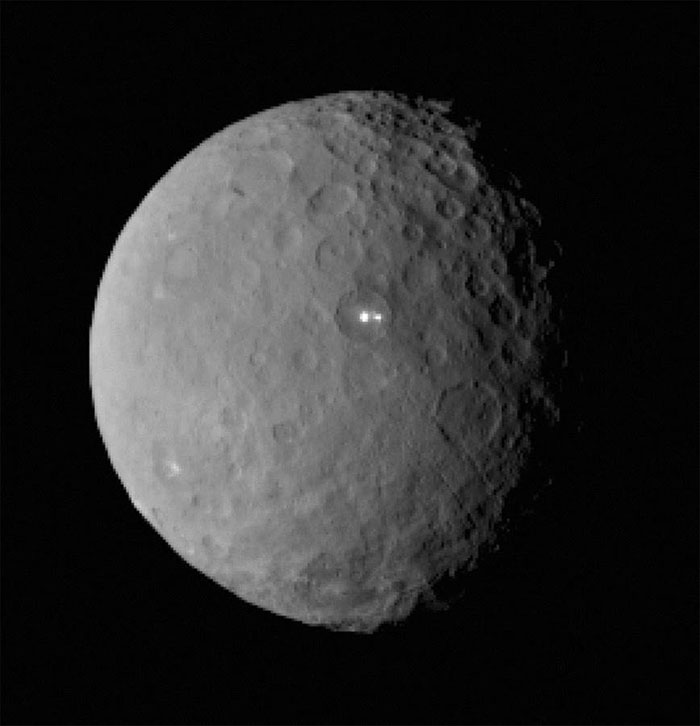
NASA's Dawn spacecraft is getting sharper views of the mysterious bright spot on the dwarf planet Ceres as the probe prepares to go into orbit — and it turns out that the spot is actually two spots, lying next to each other in the same big crater basin.
Could the spots be patches of ice, welling up from the interior of the biggest asteroid and the smallest known dwarf planet? Stay tuned.
"Right now, all we can say is that the material reflects 40 percent or more of the light falling on it," UCLA astronomer Chris Russell, the principal investigator for the Dawn mission, told NBC News in an email. "This limit is because of the resolution of the camera at this distance from Ceres. If the final answer ... is that it reflects all the light that falls on it, then the most probable reflector would be ice."
In a news release accompanying the pictures released on Wednesday, Russell said the spots may have a "volcano-like origin," but added that such an interpretation would depend on the sharper images to come. Last year, scientists reported detecting water vapor escaping from Ceres — leading them to speculate that water might be welling up from beneath the surface.
.
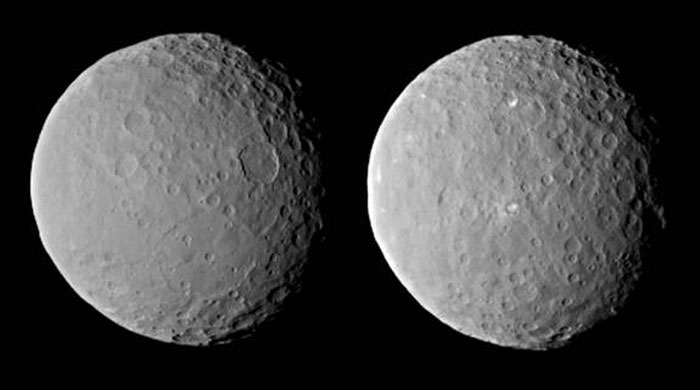
These images of the dwarf planet Ceres, processed to enhance clarity, were taken on Feb. 19 from a distance of about 29,000 miles (46,000 kilometers), by NASA's Dawn spacecraft. Dawn observed Ceres completing one full rotation, which lasted about nine hours. The images show the full range of different crater shapes that can be found at Ceres' surface: from shallow, flattish craters to those with peaks at their centers.
These newly released pictures were taken on Feb. 19, when the refrigerator-sized spacecraft was nearly 29,000 miles (46,000 kilometers) away from Ceres. The Dawn probe — which was launched in 2007 and spent the first part of its mission studying the asteroid Vesta — is due to go into orbit around Ceres on March 6. Over the course of the following year, Dawn will map the 590-mile-wide (950-kilometer-wide) mini-world from an altitude eventually swinging as low as 232 miles (373 kilometers).
Andrea Nathues, lead investigator for Dawn's framing camera team at Germany's Max Planck Institute for Solar System Research, said the white spots are still too small to resolve with the team's camera, but it's already known that they're brighter than anything else on Ceres.
"This is truly unexpected and still a mystery to us," Nathues said.
In his email, Russell noted that the brightest bodies in the outer solar system are those with icy surfaces.
"These would not last on Ceres, and so Ceres has a dark surface," Russell said, "but if there were ice below the surface it might be occasionally exposed a little bit."
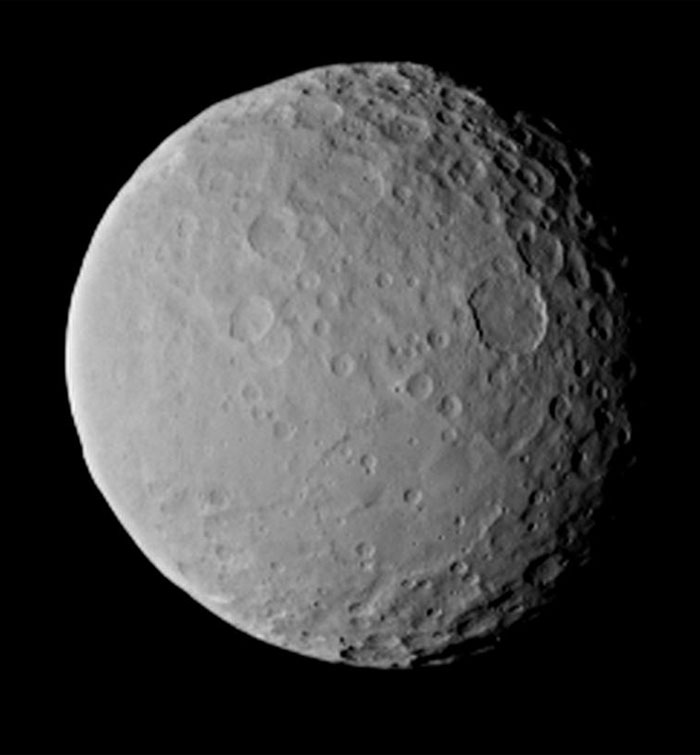
What if the spots aren't made of ice? "There could be salt on the surface, which would be more reflective than the general claylike material we think covers much of the surface," Russell said. "So there is a range of possibilities."
Even though the origin of the spots could be volcano-like, scientists have ruled out the possibility that the spots are made up of lava like that seen on Earth or on Io, one of Jupiter's moons.
"That would make a hot spot," Russell said. "We think we would have noticed a hot spot by now."
NASA will present a news briefing at noon ET March 2 focusing on the arrival of the Dawn spacecraft at Ceres. The briefing will be aired live via the NASA TV website as well as Ustream.
Quelle: NBC
.
Update: 27.02.2015
.
Verheißungsvolle Kraterlandschaften auf Zwergplanet Ceres

Nur 46 000 Kilometer trennten die Dawn-Sonde noch von ihrem Ziel, dem Zwergplaneten Ceres, als die Kamera an Bord am 19. Februar 2015 neue Aufnahmen machte. Dabei beeindruckt Ceres vor allem mit seinen unterschiedlichen Kraterformen: Neben zahlreichen eher kleineren, flachen Kratern zeigen die Bilder auch solche Einschlagsbecken, in deren Mittelpunkt sich ein Berg aufgetürmt hat. Der Durchmesser des größten Körpers im Asteroidengürtel zwischen Mars und Jupiter beträgt rund 1000 Kilometer und so könnten einzelne Krater auf seiner Oberfläche daher einen Durchmesser von ungefähr 300 Kilometern haben. Zurzeit befindet sich die Sonde im Endspurt: Am 6. März 2015 soll sie Ceres erreichen und somit die erste Raumsonde sein, die einen Zwergplaneten aus der Nähe untersucht. Ab Mai 2015 beginnt das Deutsche Zentrum für Luft- und Raumfahrt (DLR) mit der Kartierung des Zwergplaneten.
Eine Mission, zwei Himmelskörper
Schwenkt Dawn in den Orbit um Ceres, ist dies schon der zweite Himmelskörper in den Tiefen des Weltalls, den die Mission erkundet: 2007 gestartet, umkreiste die Sonde 2011 den Asteroiden Vesta. Auch dort stießen die Wissenschaftler auf eine abwechslungsreiche Asteroidenoberfläche mit Kratern, Bergen, Canyons und Furchen. "Auch Ceres zeigt bereits während des Anflugs die unterschiedlichsten Formen an seiner Oberfläche", sagt Prof. Ralf Jaumann vom DLR-Institut für Planetenforschung. "Diese Strukturen weisen darauf hin, dass sich die Oberfläche von Ceres im Laufe der Zeit durch gewaltige Prozesse veränderte." Neben den Kratern sind auch hellere Regionen zu erkennen, die jedoch aus einer Entfernung von 46 000 Kilometern noch nicht gedeutet werden können - noch haben die Bilder eine Auflösung von nur vier Kilometern auf der Asteroidenoberfläche.
Ceres ist für die Forscher besonders spannend, weil sie unter seiner Kruste einen Ozean vermuten. Im Gegensatz zu Vesta - einem "trockenen" Asteroiden - ist das zweite Ziel der Dawn-Mission ein "nasser" Asteroid, der hinter der Frostgrenze liegt und vermutlich einen Wasseranteil von 15 bis 25 Prozent aufweist. "Wir untersuchen mit einer Mission zwei sehr unterschiedliche Typen von Asteroiden", betont DLR-Planetenforscher Prof. Ralf Jaumann. Beide Himmelskörper sollen Aufschluss über die Entstehung unseres Sonnensystems geben, denn sie haben sich seit ihrer Entstehung vor viereinhalb Milliarden Jahren vermutlich kaum mehr verändert.
Die Mission
Die Dawn Mission wird vom Jet Propulsion Laboratory (JPL) der amerikanischen Weltraumbehörde NASA geleitet. JPL ist eine Abteilung des California Institute of Technology in Pasadena. Die University of California in Los Angeles ist für den wissenschaftlichen Teil der Mission verantwortlich. Das Kamerasystem an Bord der Raumsonde wurde unter Leitung des Max-Planck-Instituts für Sonnensystemforschung in Göttingen in Zusammenarbeit mit dem Institut für Planetenforschung des Deutschen Zentrums für Luft- und Raumfahrt (DLR) in Berlin und dem Institut für Datentechnik und Kommunikationsnetze in Braunschweig entwickelt und gebaut. Das Kamera-Projekt wird finanziell von der Max-Planck-Gesellschaft, dem DLR und NASA/JPL unterstützt.
Quelle: DLR
.
Update: 2.03.2015
.
Raumsonde Dawn auf der Zielstrecke
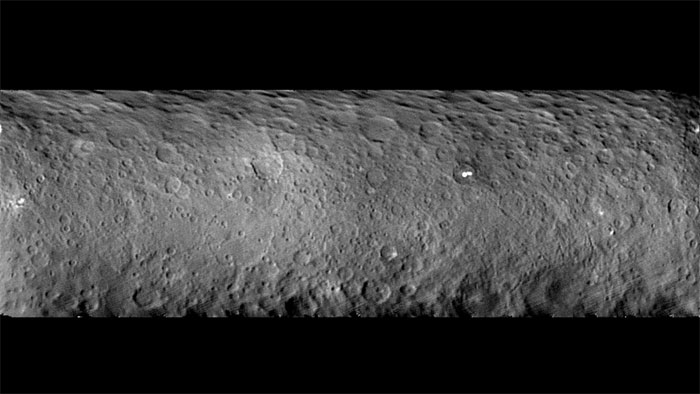
Nur noch wenige Tage wird es dauern, bis die Raumsonde Dawn am 6. März 2015 in den Orbit um Ceres geht und somit zum ersten Mal überhaupt einen Zwergplanet besucht wird. Was Ceres den Wissenschaftlern bisher preisgegeben hat, wirft zurzeit nur noch mehr Fragen als Antworten auf: "So punktgenaue, extrem helle Flecken, wie wir sie auf den Kameraaufnahmen sehen, sind ungewöhnlich und bisher einfach noch nicht zu deuten - eine Erklärung wäre freigelegtes Eis, das das Licht stark reflektiert", sagt Prof. Ralf Jaumann vom Deutschen Zentrum für Luft- und Raumfahrt (DLR). Und auch die vielen unterschiedlichen Formen der Krater und ihr Erhaltungszustand haben die Wissenschaftler so nicht erwartet. Der Zwergplanet hat beispielsweise einen Krater mit einem Durchmesser von 300 Kilometern, der flacher ist, als es für einen Einschlagskrater üblich ist, aber auch Krater mit hohem Rand und einem Berg in der Mitte. "Ganz ehrlich: Ceres ist viel spannender als ich gedacht habe", betont DLR-Planetenforscher Ralf Jaumann.
Unbekannte Welten in 500 Millionen Kilometern Entfernung
Von Juli 2011 bis September 2012 umkreiste die amerikanische Raumsonde Dawn den Asteroiden Vesta, seitdem reist sie durch das All, um vom ersten Untersuchungsobjekt zum zweiten Missionsziel, dem Zwergplaneten Ceres, zu gelangen. Über 228 Millionen Kilometer hat Dawn dabei zurückgelegt, die Frostgrenze im Asteroidengürtel zwischen Jupiter und Mars hinter sich gelassen und befindet sich nun über 500 Millionen Kilometer entfernt von der Erde. Mit der Annäherung an Ceres wachsen Neugier und Spannung bei den Wissenschaftlern. Erstmals erkundet eine Sonde gleich zwei Himmelskörper in einer Mission: Asteroid Vesta war ein "trockener", felsiger Asteroid, zerfurcht, voller Krater, Berge und Canyons - Zwergplanet Ceres wird als "nasser", eisiger Asteroid nicht nur eine dreckige, staubige Eiskruste, sondern wohlmöglich auch einen darunterliegenden Ozean aus Wasser haben.
So unterschiedlich die beiden Himmelskörper im Asteroidengürtel sind, konservieren dennoch beide frühe Entwicklungsstufen unserer Planeten: "Beide Körper sind Fossilien aus der Geburtsstunde des Sonnensystems und werfen Licht auf dessen Entstehung", sagt die stellvertretende wissenschaftliche Missionsleiterin Carol Raymond vom Jet Propulsion Laboratory (JPL) der NASA. Vesta mit einem Durchmesser von 530 Kilometern und Ceres mit beinahe 1000 Kilometern Durchmesser sind zwar die einzigen intakten Asteroiden, wurden aber letztendlich nie zu Planeten - dies verhinderte die Anziehungskraft von Jupiter. "Wir werden mit der Dawn-Mission vieles lernen, das uns die Entstehung unseres Sonnensystems vor 4,5 Milliarden Jahren besser verstehen lässt", ist DLR-Planetenforscher Prof. Ralf Jaumann überzeugt.
Vielversprechend und rätselhaft zugleich
Bei Asteroid Vesta stießen die Wissenschaftler auf eine erstaunliche und wissenschaftlich spannende neue Welt. Und auch Zwergplanet Ceres erweist sich bereits im Anflug als vielversprechend und rätselhaft zugleich. Schon die extrem hellen Flecken, die sich in einem Krater von Ceres zeigen, sorgen für die Diskussionen und Spekulationen: "Sie sind ein ziemliches Rätsel – nicht nur für Laien, sondern auch für uns Planetenforscher", sagt Prof. Ralf Jaumann vom DLR-Institut für Planetenforschung. Aus 46 000 Kilometern Entfernung aufgenommen, nehmen die Flecken gerade einmal einen Pixel ein und sind somit kleiner als vier Quadratkilometer. Für eine detaillierte Erklärung ist das noch zu wenig. "Es könnte Kryo-Vulkanismus sein, es könnte freigelegtes Eis sein, wir müssen einfach abwarten, bis wir Aufnahmen mit einer besseren Auflösung haben." Immerhin konnte ein Infrarot-Spektrometer auf dem Weltraumteleskop Herschel bereits messen, dass der Zwergplanet Wasserdampf in seiner Umgebung hat. Ein Zusammenhang zwischen dem Ausstoß von Wasserdampf und den hellen Flecken ist möglich. Doch erst wenn die Umlaufbahn um Ceres erreicht ist und die Sonde den Zwergplaneten aus der Nähe umfliegt, werden Erklärungen möglich sein.
Auch die Krater, ihre Form und Verteilung weisen darauf hin, dass Ceres ein lohnenswertes Untersuchungsobjekt sein wird: Hier hatten die Forscher – vor allem am Äquator - eher eine flache Oberfläche erwartet, da eine dünne Eisschicht dafür sorgen würde, dass sich Kratererhebungen mit der Zeit durch die Entspannung des Eises senken und einebnen würden. Nun gibt es aber nicht nur einen großen Krater, der kaum noch wie ein Einschlagskrater aussieht, sondern zudem auch markante Kraterformen mit einem aufgetürmten Berg im Mittelpunkt. Die gesamte Oberfläche des Zwergplaneten ist dabei sehr abwechslungsreich und zeigt verteilt über seine gesamte Fläche die unterschiedlichsten Strukturen. "Wie dick die Eiskruste ist, die wir unter der staubbedeckten Oberfläche vermuten, werden wir erst mit der Erforschung dieser Kraterformen ableiten können", sagt Prof. Ralf Jaumann.
Fahrplan bis zum Missionsende
Nachdem die Sonde Dawn am 6. März 2015 in 41 000 Kilometern Entfernung von Ceres‘ Gravitation eingefangen wird, werden zunächst bis zum 10. April keinen weiteren Aufnahmen erfolgen. In April und Mai wird der Zwergplanet dann 20 Tage lang aus einer Umlaufbahn in 13 500 Kilometern erforscht. Im Juni geht es auf eine Höhe von 4400 Kilometern sowie 1470 Kilometern hinunter. Die größte Annäherung erfolgt dann im Dezember 2015, wenn Dawn in nur noch 375 Kilometern Abstand um Ceres kreist. 14 Monate – bis Ende Juni 2016 – werden die Planetenforscher kontinuierlich Daten gewinnen und Ceres erforschen. Geht der Treibstoff aus, kann Dawn seine Instrumente auch nicht mehr ausrichten und wird als künstlicher Satellit noch lange um den Zwergplaneten kreisen.
Die dritte Dimension
"Viele Rätsel, die Ceres uns zurzeit noch aufgibt, werden wir erst mit der dritten Dimension lösen können", sagt Wissenschaftler Prof. Ralf Jaumann. Und diese wird es ab Mai 2015 geben, wenn Dawn den Zwergplaneten mit der Kamera systematisch aus verschiedenen Blickwinkeln aufzeichnen wird und anschließend das DLR-Institut für Planetenforschung ein dreidimensionales Höhenmodell des Himmelskörpers erstellt. Dazu wurde im DLR-Institut exakt geplant, wie viele Bilder an welchem Punkt aufgenommen werden müssen, um schließlich erstmals eine genaue Topographie eines Zwergplaneten zu berechnen - eines Himmelskörpers in 500 Millionen Kilometern Entfernung von der Erde.
Die Mission
Die Mission DAWN wird vom Jet Propulsion Laboratory (JPL) der amerikanischen Weltraumbehörde NASA geleitet. JPL ist eine Abteilung des California Institute of Technology in Pasadena. Die University of California in Los Angeles ist für den wissenschaftlichen Teil der Mission verantwortlich. Das Kamerasystem an Bord der Raumsonde wurde unter Leitung des Max-Planck-Instituts für Sonnensystemforschung in Göttingen in Zusammenarbeit mit dem Institut für Planetenforschung des Deutschen Zentrums für Luft- und Raumfahrt (DLR) in Berlin und dem Institut für Datentechnik und Kommunikationsnetze in Braunschweig entwickelt und gebaut. Das Kamera-Projekt wird finanziell von der Max-Planck-Gesellschaft, dem DLR und NASA/JPL unterstützt.
Quelle: DLR
.
Update: 3.03.2015
.
NASA Spacecraft Nears Historic Dwarf Planet Arrival
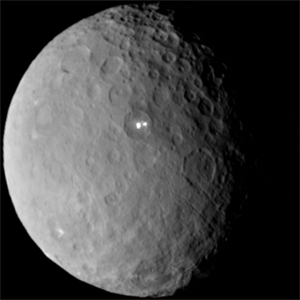
Ceres rotates in this sped-up movie comprised of images taken by NASA's Dawn mission during its approach to the dwarf planet. The images were taken on Feb. 19, 2015, from a distance of nearly 29,000 miles (46,000 kilometers). Dawn observed Ceres for a full rotation of the dwarf planet, which lasts about nine hours. The images have a resolution of 2.5 miles (4 kilometers) per pixel.
NASA’s Dawn spacecraft has returned new images captured on approach to its historic orbit insertion at the dwarf planet Ceres. Dawn will be the first mission to successfully visit a dwarf planet when it enters orbit around Ceres on Friday, March 6.
"Dawn is about to make history," said Robert Mase, project manager for the Dawn mission at NASA’s Jet Propulsion Laboratory (JPL) in Pasadena, California. "Our team is ready and eager to find out what Ceres has in store for us."
Recent images show numerous craters and unusual bright spots that scientists believe tell how Ceres, the first object discovered in our solar system’s asteroid belt, formed and whether its surface is changing. As the spacecraft spirals into closer and closer orbits around the dwarf planet, researchers will be looking for signs that these strange features are changing, which would suggest current geological activity.
“Studying Ceres allows us to do historical research in space, opening a window into the earliest chapter in the history of our solar system,” said Jim Green, director of NASA’s Planetary Science Division at the agency’s Headquarters in Washington. “Data returned from Dawn could contribute significant breakthroughs in our understanding of how the solar system formed.”
Dawn began its final approach phase toward Ceres in December. The spacecraft has taken several optical navigation images and made two rotation characterizations, allowing Ceres to be observed through its full nine-hour rotation. Since Jan. 25, Dawn has been delivering the highest-resolution images of Ceres ever captured, and they will continue to improve in quality as the spacecraft approaches.
Sicilian astronomer Father Giuseppe Piazzi spotted Ceres in 1801. As more such objects were found in the same region, they became known as asteroids, or minor planets. Ceres was initially classified as a planet and later called an asteroid. In recognition of its planet-like qualities, Ceres was designated a dwarf planet in 2006, along with Pluto and Eris.
Ceres is named for the Roman goddess of agriculture and harvests. Craters on Ceres will similarly be named for gods and goddesses of agriculture and vegetation from world mythology. Other features will be named for agricultural festivals.
Launched in September 2007, Dawn explored the giant asteroid Vesta for 14 months in 2011 and 2012, capturing detailed images and data about that body. Both Vesta and Ceres orbit the sun between Mars and Jupiter, in the main asteroid belt. This two-stop tour of our solar system is made possible by Dawn’s ion propulsion system, its three ion engines being much more efficient than chemical propulsion.
"Both Vesta and Ceres were on their way to becoming planets, but their development was interrupted by the gravity of Jupiter,” said Carol Raymond, deputy project scientist at JPL. “These two bodies are like fossils from the dawn of the solar system, and they shed light on its origins."
Ceres and Vesta have several important differences. Ceres is the most massive body in the asteroid belt, with an average diameter of 590 miles (950 kilometers). Ceres' surface covers about 38 percent of the area of the continental United States. Vesta has an average diameter of 326 miles (525 kilometers), and is the second most massive body in the belt. The asteroid formed earlier than Ceres and is a very dry body. Ceres, in contrast, is estimated to be 25 percent water by mass.
"By studying Vesta and Ceres, we will gain a better understanding of the formation of our solar system, especially the terrestrial planets and most importantly the Earth," said Raymond. "These bodies are samples of the building blocks that have formed Venus, Earth and Mars. Vesta-like bodies are believed to have contributed heavily to the core of our planet, and Ceres-like bodies may have provided our water."
"We would not be able to orbit and explore these two worlds without ion propulsion,” Mase said. “Dawn capitalizes on this innovative technology to deliver big science on a small budget.”
In addition to the Dawn mission, NASA will launch in 2016 its Origins-Spectral Interpretation-Resource Identification-Security-Regolith Explorer (OSIRIS-REx) spacecraft. This mission will study a large asteroid in unprecedented detail and return samples to Earth.
NASA also places a high priority on tracking and protecting Earth from asteroids. NASA's Near-Earth Object (NEO) Program at the agency’s headquarters manages and funds the search, study and monitoring of asteroids and comets whose orbits periodically bring them close to Earth. NASA is pursuing an Asteroid Redirect Mission (ARM), which will identify, redirect and send astronauts to explore an asteroid. Among its many exploration goals, the mission could demonstrate basic planetary defense techniques for asteroid deflection.
Dawn's mission is managed by JPL for NASA's Science Mission Directorate in Washington. Dawn is a project of the directorate's Discovery Program, managed by NASA's Marshall Space Flight Center in Huntsville, Alabama. UCLA is responsible for overall Dawn mission science. Orbital ATK, Inc., in Dulles, Virginia, designed and built the spacecraft.
The German Aerospace Center, Max Planck Institute for Solar System Research, Italian Space Agency and Italian National Astrophysical Institute are international partners on the mission team.
Quelle: NASA
.
Update: 6.03.2015
-
Dawn spacecraft on final approach to Ceres
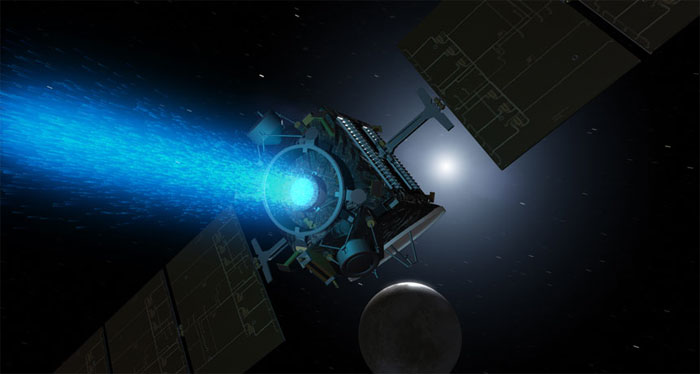
The finish line is in sight for the Dawn mission. After 7 1/2 years in space, including a 14-month stop at the asteroid Vesta, the spacecraft is about to pull up alongside the dwarf planet Ceres.
Around 7:20 a.m. Eastern time on March 6, Ceres’ gravity will take hold and start to pull the spacecraft in. The probe will not take any pictures because it’s approaching the dwarf planet from the night side. In six weeks, Dawn will enter a closer orbit and begin its 14-month mission to map Ceres, looking for clues about the birth of the solar system.
Quelle: SN
.
NASA's Dawn space probe ready to enter orbit around dwarf planet Ceres Friday morning
Shortly before 6:30 a.m. CST Friday, NASA's space probe Dawn will slide into orbit around the dwarf planet Ceres some 250 million miles from Earth. Even in an age when probes seem whizzing everywhere in space, NASA scientists say Dawn is special.
"Dawn is about to make history," project manager Robert Mase said at a press conference this week at NASA's Jet Propulsion Laboratory in Pasadena, Calif. "Our team is ready and eager to find out what Ceres has in store for us."
Also watching closely from Alabama will be managers at the Marshall Space Flight Center in Huntsville, who oversee the money, schedule and other management components of the $450 million mission. Watch mission program office manager Keith Robinson discuss his team's role in the video below.
Dawn's flight was notable before it got to Ceres. It is the first probe to orbit two space objects and spent more than a year circling and studying the asteroid Vesta. It has also been flying through space since 2007 using an innovative ion engine that could propel future interplanetary spaceships.
But Dawn's recent approach photographs show mysterious lights on Ceres, and those lights have excited scientists and the public. The best guess as to their cause now is volcanoes, but no one knows for sure.
Ceres is a Texas-sized "dwarf" orbiting in the asteroid belt between Mars and Jupiter just like Vesta. Both Vesta and Ceres date to the creation of the solar system, and they are essentially fossils from that creation, JPL scientist Dr. Carol Raymond said this week. Scientists say Ceres would have been a planet except Jupiter's gravity got in the way of its growth.
"By studying Vesta and Ceres, we will gain a better understanding of the formation of our solar system, especially the terrestrial planets and most importantly the Earth," Raymond said. "These bodies are samples of the building blocks that have formed Venus, Earth and Mars. Vesta-like bodies are believed to have contributed heavily to the core of our planet, and Ceres-like bodies may have provided our water."
NASA won't start receiving images from Dawn in orbit until late April. At its lowest, the probe will drop to 233 miles above Ceres' surface.
"We're excited NASA is pursuing these kinds of missions," Robinson said this week. "And we're glad to get the chance to support them."
Robinson's office also managed the Messenger probe to Mercury and the Juno probe in route to Jupiter.
Quelle: AL
.
Update: 11.00 MEZ
-
For NASA, Dawn Probe's Ceres Arrival Will Cap Epic Solar System Trek
PASADENA, Calif. — On Friday morning (March 6), NASA's Dawn spacecraft will slip into orbit around the dwarf planet Ceres. It's been a long journey for both the probe and the team of scientists and engineers assigned to the mission.
The proposal for the mission was submitted in the late 1990s, said Carol Raymond, deputy principal investigator for the Dawn mission. "It's been a long haul," she told Space.com. "We've been through a lot of ups and downs to get to these two unexplored worlds."
After launching in 2007, the Dawn spacecraft reached its first target, the asteroid Vesta in the main belt of asteroids between Mars and Jupiter, in July 2011.
.
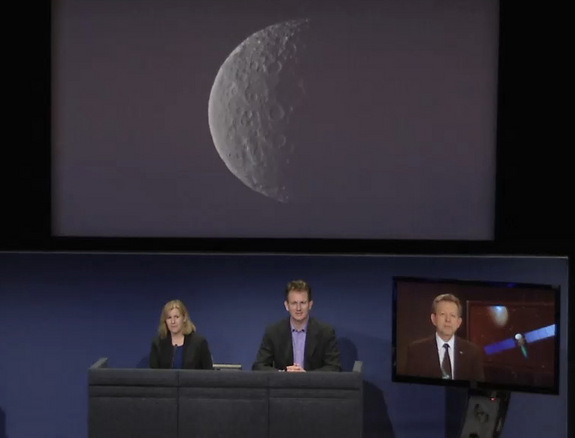
Deputy principal investigator for the Dawn mission Carol Raymond on left, and Robert Mase, Dawn's project manager, at a Jet Propulsion Laboratory news conference.
.
After spending 14 months surveying Vesta, Dawn was prepared to depart for Ceres — the largest body in the asteroid belt — using its low-thrust, high-efficiency ion engine. But one of its reaction wheels, used to stabilize the probe in space, had begun to fail just prior to arriving at Vesta in 2010. This was troublesome but not critical. Then, as the flight team prepared to depart the asteroid in 2012, a second reaction wheel began showing signs of ill health. By the time Dawn left Vesta's orbit, two reaction wheels had suffered crippling malfunctions.
"We got a bad batch," Raymond said, referring to the reaction wheels. "They failed within a matter of hours or a day."
With two of the four reaction wheels down, the $450 million mission faced a potential crisis.
"That became a mission-limiting resource … We were using more hydrazine [the chemical used to fuel the spacecraft's thrusters] for maneuvering," Raymond said. "Because we have a fixed antenna, we are either looking at a surface, gathering data or turned towards the Earth to send it back. So, we have consequently had to reduce the number of turns, to be most efficient."
Dawn is propelled through space by a cutting-edge ion engine, which uses a high electrical charge generated by its 65-foot-wide (20 meters) solar panels to expel xenon gas fuel at a high velocity. This creates a small but continuous thrust. The spacecraft can reach very high velocities over long periods of time. But for directional maneuvering and orientation, Dawn was designed to depend on the reaction wheels and, to a lesser degree, the hydrazine-fueled maneuvering thrusters.
"The team has done a great job of planning slower turns and fewer turns. If Dawn were a Prius, we would be hypermiling right now," Raymond said. ("Hypermiling" is the process of creatively maximizing the Toyota hybrid's fuel economy.)

Her team will be bulking up as the spacecraft slowly circles into its science orbit, the altitude from which the onboard instrumentation can do optimal work.
"Right now, the team is about 40 people, not including the science team," Raymond added. "The science team has about two dozen, and we are about to get a few new investigators from NASA. We also have large teams in Europe associated with the German camera and the Italian spectrometer [two instruments on Dawn]."
Raymond is no stranger to cold and icy places, and is looking forward to investigating the two bright patches now visible on Ceres, thought to possibly be ice deposits.
"I came to planetary science kind of late," she said. "My background was in Earth science. I did a lot of work in Antarctica, though, so ice is not too far afield!"
"It's just thrilling," Raymond said. "This is truly the highlight of my career."

Quelle: SC
.
Update: 20.00 MEZ / LIVE
.
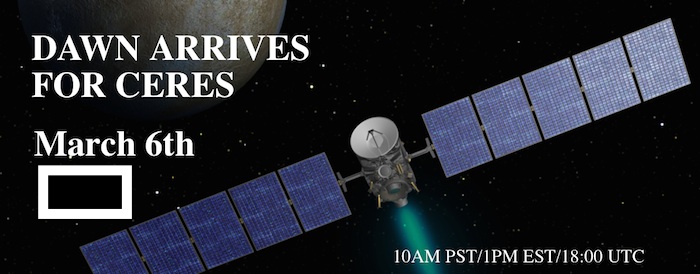

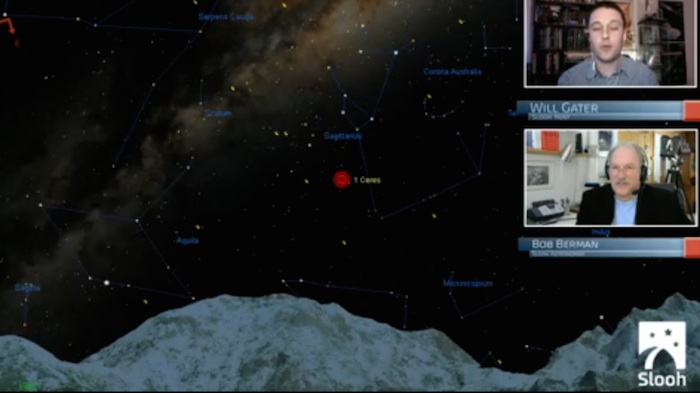
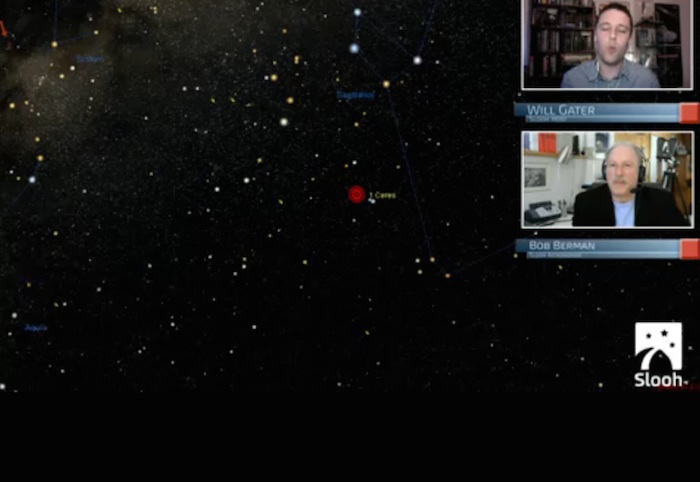
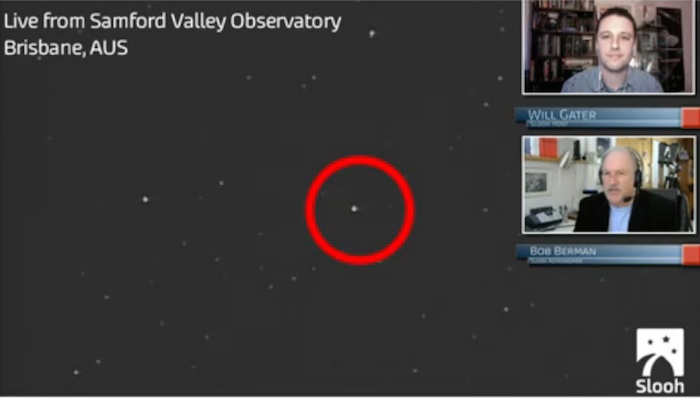
...20.15 MEZ
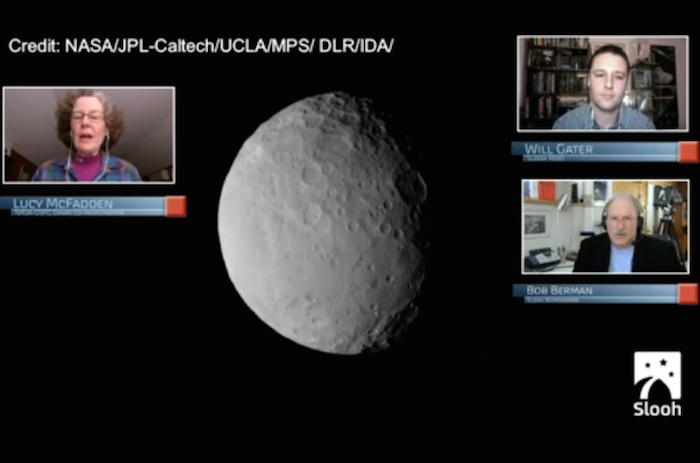

...20.30 MEZ
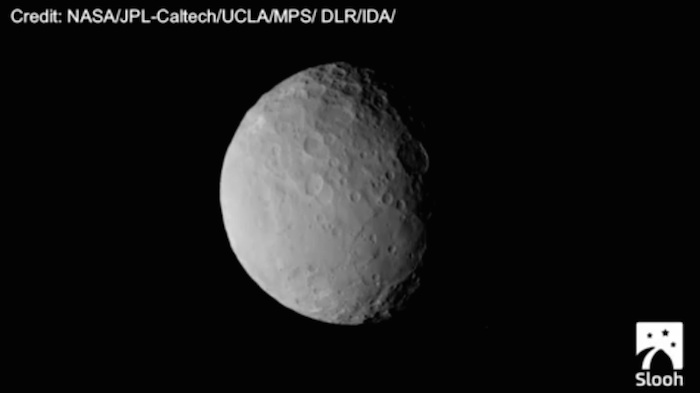
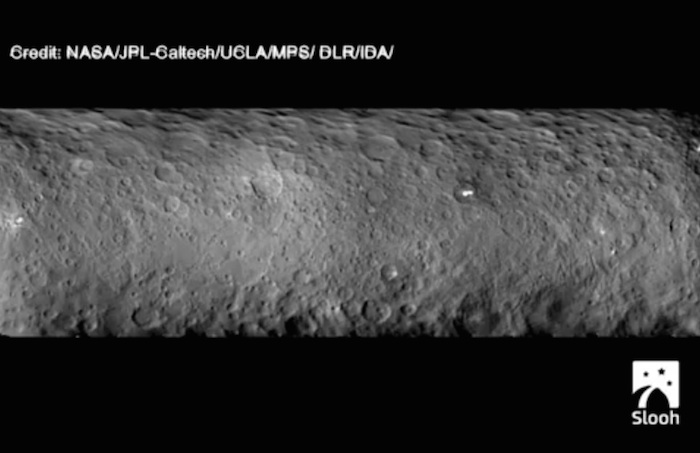
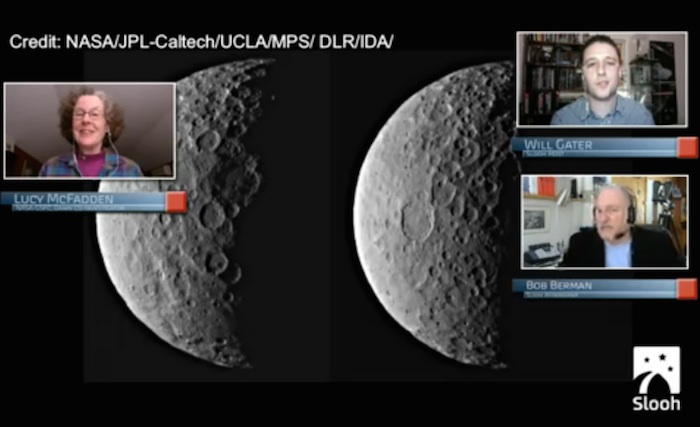
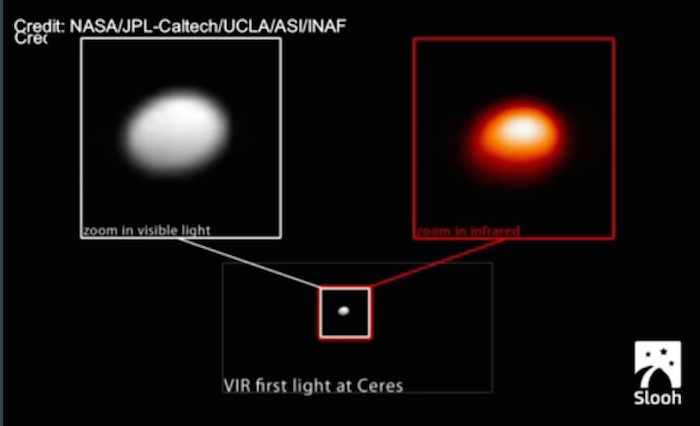
...21.00 MEZ
-
NASA Spacecraft Becomes First to Orbit a Dwarf Planet
-
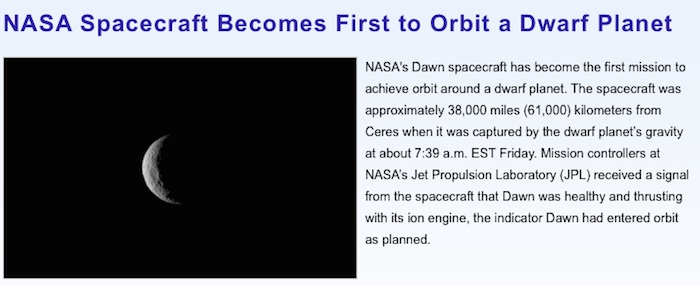
-
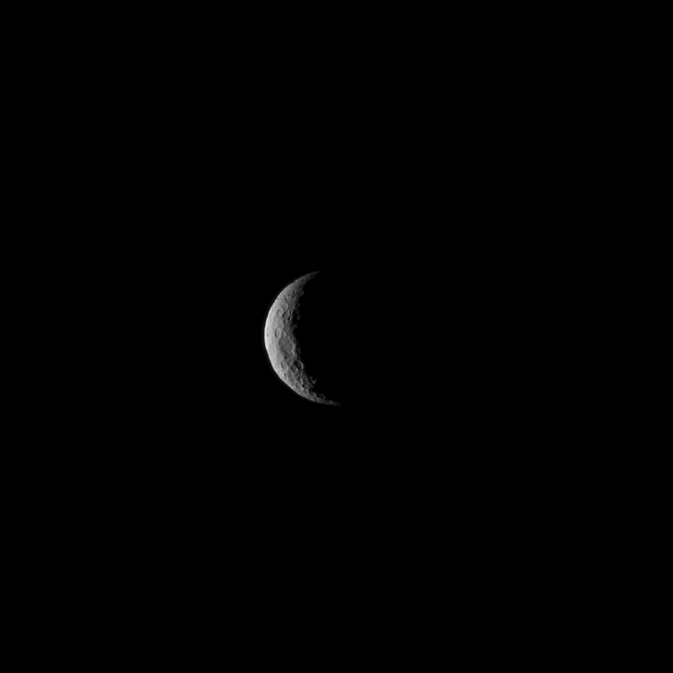
Ceres is seen from NASA's Dawn spacecraft on March 1, just a few days before the mission achieved orbit around the previously unexplored dwarf planet. The image was taken at a distance of about 30,000 miles (about 48,000 kilometers).
Image Credit: NASA/JPL-Caltech/UCLA/MPS/DLR/IDA
.
NASA's Dawn spacecraft has become the first mission to achieve orbit around a dwarf planet. The spacecraft was approximately 38,000 miles (61,000 kilometers) from Ceres when it was captured by the dwarf planet’s gravity at about 4:39 a.m. PST (7:39 a.m. EST) Friday.
Mission controllers at NASA’s Jet Propulsion Laboratory (JPL) in Pasadena, California received a signal from the spacecraft at 5:36 a.m. PST (8:36 a.m. EST) that Dawn was healthy and thrusting with its ion engine, the indicator Dawn had entered orbit as planned.
"Since its discovery in 1801, Ceres was known as a planet, then an asteroid and later a dwarf planet," said Marc Rayman, Dawn chief engineer and mission director at JPL. "Now, after a journey of 3.1 billion miles (4.9 billion kilometers) and 7.5 years, Dawn calls Ceres, home."
In addition to being the first spacecraft to visit a dwarf planet, Dawn also has the distinction of being the first mission to orbit two extraterrestrial targets. From 2011 to 2012, the spacecraft explored the giant asteroid Vesta, delivering new insights and thousands of images from that distant world. Ceres and Vesta are the two most massive residents of our solar system’s main asteroid belt between Mars and Jupiter.
The most recent images received from the spacecraft, taken on March 1 show Ceres as a crescent, mostly in shadow because the spacecraft's trajectory put it on a side of Ceres that faces away from the sun until mid-April. When Dawn emerges from Ceres' dark side, it will deliver ever-sharper images as it spirals to lower orbits around the planet.
"We feel exhilarated," said Chris Russell, principal investigator of the Dawn mission at the University of California, Los Angeles (UCLA). "We have much to do over the next year and a half, but we are now on station with ample reserves, and a robust plan to obtain our science objectives."
Dawn's mission is managed by JPL for NASA's Science Mission Directorate in Washington. Dawn is a project of the directorate's Discovery Program, managed by NASA's Marshall Space Flight Center in Huntsville, Alabama. UCLA is responsible for overall Dawn mission science. Orbital ATK Inc., in Dulles, Virginia, designed and built the spacecraft. The German Aerospace Center, Max Planck Institute for Solar System Research, Italian Space Agency and Italian National Astrophysical Institute are international partners on the mission team.
Quelle: NASA
.
Update: 7.03.2015
.
Im Bann der eisigen Ceres
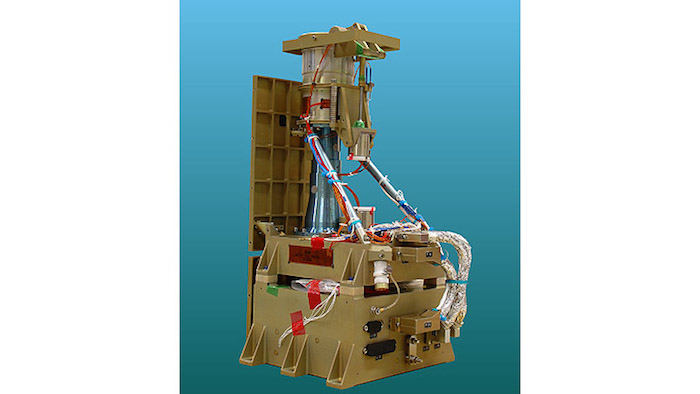
Framing Camera / Dawn-Sonde
.
Die Raumsonde Dawn ist in ihrer Umlaufbahn um den Zwergplaneten Ceres angekommen - seit dem 6. März 2015, 13.39 Uhr mitteleuropäischer Zeit, kreist sie um den Himmelskörper. Damit Dawn von Ceres‘ Anziehungskraft in einen Orbit gezogen werden konnte, bremsten die Ionentriebwerke die Raumsonde in 61 000 Kilometern Entfernung von dem Zwergplaneten ab. Während dieses Vorgangs waren keine Aufnahmen mit der Kamera an Bord möglich. "Die insgesamt fast 20 Meter langen Solarpaneele mussten bei diesem Manöver zur Sonne ausgerichtet sein, und daher blickte die Kamera auch nicht in Richtung Ceres", sagt Prof. Ralf Jaumann vom Deutschen Zentrum für Luft- und Raumfahrt (DLR). Der Planetenforscher ist Mitglied im Kamerateam - und wartet gespannt auf die nächsten Bilder, die im April aus 33 000 und 22 000 Kilometern Abstand aufgenommen werden. Doch zunächst verschwindet die Raumsonde Dawn nun bis Mitte April hinter der dunklen, sonnenabgewandten Seite des Zwergplaneten.
Immer näher an die Oberfläche
Siebeneinhalb Jahre nach dem Start und nach fast fünf Milliarden geflogener Kilometer ist Dawn somit an ihrem zweiten Missionsziel angekommen. Ihr erstes Ziel, den Asteroiden Vesta, umkreiste sie von 2011 bis 2012 und lieferte tausende Bilder. Auch ihre Umlaufbahn um Ceres wird nach und nach näher an den Zwergplaneten führen. Ab dem 23. April 2015 wird die Kamera aus nur noch 13 500 Kilometern Entfernung auf die Oberfläche von Ceres blicken und 20 Tage lang den Zwergplaneten aus dieser Höhe erforschen. "Dann können wir schon viel mehr Details erkennen und interpretieren", betont DLR-Planetenforscher Ralf Jaumann. "Und auch die dritte Dimension, das heißt das topographische Relief der Oberfläche, können wir dann zunehmend besser bestimmen." Dann soll auch das erste vollständige dreidimensionale Höhenmodell am DLR-Institut für Planetenforschung entstehen. Bis Ende dieses Jahres wird sich Dawn dann bis auf 375 Kilometer an Ceres annähern. Insgesamt 18 Monate soll die Raumsonde mit insgesamt drei Instrumenten den Zwergplaneten erforschen.
Ceres wurde 1801 entdeckt und als Planet bezeichnet. Später wurde er als Asteroid klassifiziert - um schließlich 2006 in die neu definierte Klasse der Zwergplaneten eingeordnet zu werden. Mit seiner Umlaufbahn um die Sonne, der Kugelform und einem Durchmesser von 950 Kilometern war Ceres bei der Entstehung unseres Sonnensystems auf dem besten Weg, ein Planet zu werden. Doch die Gravitation von Jupiter verhinderte dies sehr wahrscheinlich, und so blieb Ceres in dieser Entwicklung stecken. Das macht Ceres interessant für die Planetenforscher: "Er verkörpert ein Stadium der Planetenentstehung, das uns Aufschluss darüber geben kann, was vor 4,6 Milliarden Jahren passierte", sagt Prof. Ralf Jaumann.
Die Mission
Die Mission DAWN wird vom Jet Propulsion Laboratory (JPL) der amerikanischen Weltraumbehörde NASA geleitet. JPL ist eine Abteilung des California Institute of Technology in Pasadena. Die University of California in Los Angeles ist für den wissenschaftlichen Teil der Mission verantwortlich. Das Kamerasystem an Bord der Raumsonde wurde unter Leitung des Max-Planck-Instituts für Sonnensystemforschung in Göttingen in Zusammenarbeit mit dem Institut für Planetenforschung des Deutschen Zentrums für Luft- und Raumfahrt (DLR) in Berlin und dem Institut für Datentechnik und Kommunikationsnetze in Braunschweig entwickelt und gebaut. Das Kamera-Projekt wird finanziell von der Max-Planck-Gesellschaft, dem DLR und NASA/JPL unterstützt.
Quelle: DLR
.
Update: 18.03.2015
.

-
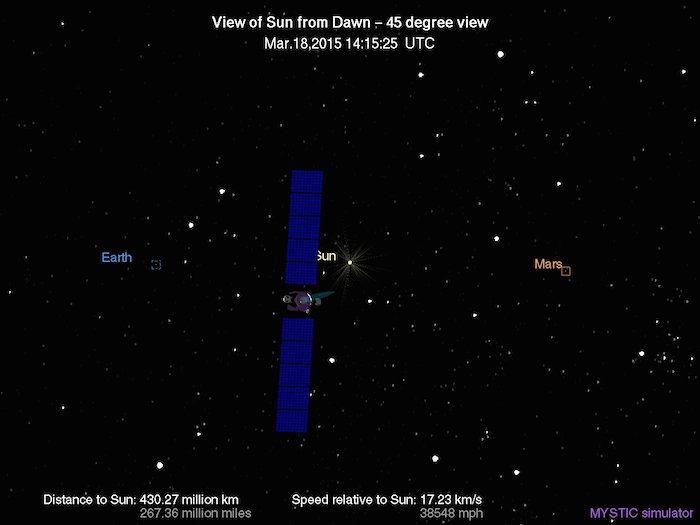
Quelle: NASA
.
Update: 19.03.2015
.
Helle Flecken auf Ceres könnten Wasser Vulkane sein
As NASA's Dawn spacecraft pulled into orbit earlier this month around the dwarf planet Ceres in the asteroid belt, it spotted a mysterious bright spot inside a crater. There were suspicions that the spot could be caused by water spewing into space, now fresh views, presented for the first time yesterday, lend weight to the idea.
The pictures show the bright spot is visible even from the side, meaning it probably protrudes above the crater. "What is amazing is you can see this feature while the rim is very likely in front of the line of sight," said Andreas Nathues, who is in charge of the mission's camera, and presented the images yesterday at the Lunar and Planetary Science conference (LPSC) in The Woodlands, Texas. "We believe this could be some kind of outgassing."
Images taken from dusk to dawn on Ceres show that the spot brightens throughout the day and completely disappears at night. This suggests it could be a pocket of ice on the surface that is being heated by the sun and releasing gas, similarly to how a comet behaves. However, Natheus said the team needed higher resolution data to confirm its true nature. This won't come for a while, as Dawn is currently on the dark side of Ceres and won't emerge until mid-April.
Distant observations using the Herschel telescope show Ceres is spitting water from somewhere on its surface, but only Dawn will be able to pinpoint the location. Revealing the origin of Ceres's water could determine whether there is the potential for life beneath its surface, as is thought to be the case on icy moons around Jupiter and Saturn.
But a model of Ceres presented at the LPSC has added a wrinkle by suggesting comet-like behaviour is only possible at the poles of the dwarf planet, not the lower-latitude areas where the bright spot has been seen.
Comet jets and cryo-volcanoes
Timothy Titus of the US Geological Survey in Flagstaff, Arizona, presented a thermal model that examines where on the surface ice could remain stable over the life time of the solar system, rather than boiling away more quickly. If Ceres is acting like a comet, it must have ice patches that can survive for a long time before being heated by the sun as it moves into a warmer part of its orbit.
Titus found that ice could only be stable in regions above 40 degrees latitude. But the plumes spotted by Herschel seemed to come from nearer the equator, which implies they can't be comet-like. "The water ice is just not stable at the latitudes that the plumes are supposedly coming from," Titus says.
Another explanation is cryovolcanism, in which ice and water are forced out of the surface by processes similar to those that drive magma volcanoes on Earth. But according to a second model presented at the LPSC by David O'Brien of the Planetary Science Institute in Tucson, Arizona, Ceres doesn't have enough muscle to drive these eruptions.
Water down deep
The idea is that Ceres has a subsurface ocean covered by an icy shell. As the bottom of the shell freezes, it expands, putting pressure on the ocean and the shell itself. In order to create a cryovolcano, says O'Brien, the water pressure needs to build up enough to launch up through the shell before the ice cracks and relieves the pressure.
We don't know exactly how deep the ice is on Ceres, so O'Brien tried a range of plausible depths. None produced the conditions for spewing cryovolcanoes – the ice always cracked before enough pressure built up. The best case scenario was water reaching about 90 per cent of the way to the surface.
Intriguingly, that means water could potentially reach the surface from a deep crater, where there was less ice to get through – perhaps even from a crater like the one where Dawn saw the bright spot. That doesn't mean there is a cryovolcano producing a massive plume, but it could be just enough to replenish the ice on the surface, countering the instability that Titus discovered.
So Ceres could be producing comet-like emissions in this region, driven by a weak cryovolcano. "It's sort of a midpoint between comets and cryovolcanic icy worlds," says Titus.
There is more than one way to make a cryovolcano, though. Some models suggest the core of Ceres may be heated by radioactive isotopes left over from the dwarf planet's formation. These could provide enough energy for punchier volcanism, perhaps producing larger plumes – and heat would of course be beneficial for any bacteria that may be lurking below the surface. "Any place you've got the potential for liquid water, you've got the potential for life," says Titus. "Ceres could be an extremely exciting astrobiological target."
Quelle: NewScientist
.
Update: 7.04.2015
-
DAWN-Sonde in ausgezeichneter Form einen Monat nach Ankunft bei Ceres
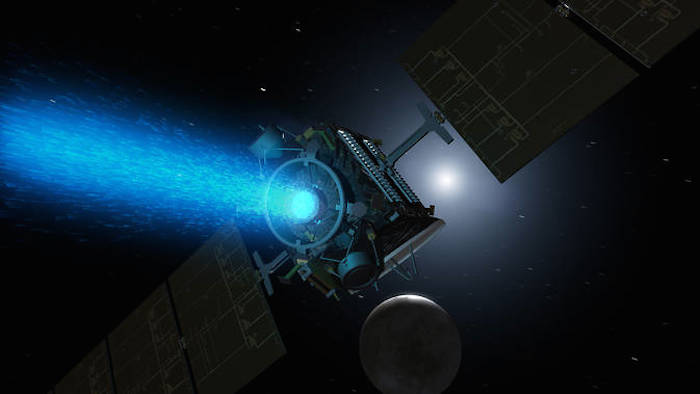
Artist's concept of Dawn above Ceres around the time it was captured into orbit by the dwarf planet in early March. Since its arrival, the spacecraft turned around to point the blue glow of its ion engine in the opposite direction.
Image Credit: NASA/JPL-Caltech
.
Since its capture by the gravity of dwarf planet Ceres on March 6, NASA's Dawn spacecraft has performed flawlessly, continuing to thrust with its ion engine as planned. The thrust, combined with Ceres' gravity, is gradually guiding the spacecraft into a circular orbit around the dwarf planet. All of the spacecraft's systems and instruments are in excellent health.
Dawn has been following its planned trajectory on the dark side of Ceres -- the side facing away from the sun -- since early March. After it entered orbit, the spacecraft's momentum carried it to a higher altitude, reaching a maximum of 46,800 miles (75,400 kilometers) on March 18. Today, Dawn is about 26,000 miles (42,000 kilometers) above Ceres, descending toward the first planned science orbit, which will be 8,400 miles (13,500 kilometers) above the surface.
The next optical navigation images of Ceres will be taken on April 10 and April 14, and are expected to be available online after initial analysis by the science team. In the first of these, the dwarf planet will appear as a thin crescent, much like the images taken on March 1, but with about 1.5 times higher resolution. The April 14 images will reveal a slightly larger crescent in even greater detail. Once Dawn settles into the first science orbit on April 23, the spacecraft will begin the intensive prime science campaign.
By early May, images will improve our view of the entire surface, including the mysterious bright spots that have captured the imaginations of scientists and space enthusiasts alike. What these reflections of sunlight represent is still unknown, but closer views should help determine their nature. The regions containing the bright spots will likely not be in view for the April 10 images; it is not yet certain whether they will be in view for the April 14 set.
On May 9, Dawn will complete its first Ceres science phase and begin to spiral down to a lower orbit to observe Ceres from a closer vantage point.
Dawn previously explored the giant asteroid Vesta for 14 months, from 2011 to 2012, capturing detailed images and data about that body.
Dawn's mission is managed by NASA's Jet Propulsion Laboratory, Pasadena, California, for NASA's Science Mission Directorate in Washington. Dawn is a project of the directorate's Discovery Program, managed by NASA's Marshall Space Flight Center in Huntsville, Alabama. UCLA is responsible for overall Dawn mission science. Orbital ATK Inc., in Dulles, Virginia, designed and built the spacecraft.
Quelle: NASA
5548 Views
